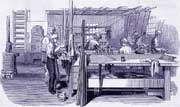The Auburn System
The Auburn prison system, often referred to as the "congregate system," is first implemented in 1819 at the New York State Prison at Auburn. Though it too incorporates Quaker ideals of reformation — humane conditions from bedding to health care, strict routines, and religious contemplation — it is considered a less pure model than the Philadelphia system. Prisoners are together, side by side, during work, meals, and prayer but return to solitary cells at night. Silence is enforced at all times, even among groups. Usually, the inmates' work consists of hard labor, such as the construction of roads or buildings. This is considered the route to repentance and salvation. Inmates march in unison, in a formation known as the lock step, which will remain in use at many prisons into the 21st century.
Auburn introduces the tier system, different levels of cells built above one another, in which convicts are housed according to their offense category — first timers vs. repeaters, murderers vs. thieves, and so forth. Inmates wear uniforms of different colors, depending on their classification. The work regimen produces income that the Pennsylvania system could not generate, and this system is by far more cost effective and practical. Inmates are less likely to go mad, and it is easier to feed everyone in a group. The Auburn philosophy quickly becomes the model for prisons nationally and internationally.
 |
| Massachusetts State Prison Whip Making Department, 1853 |